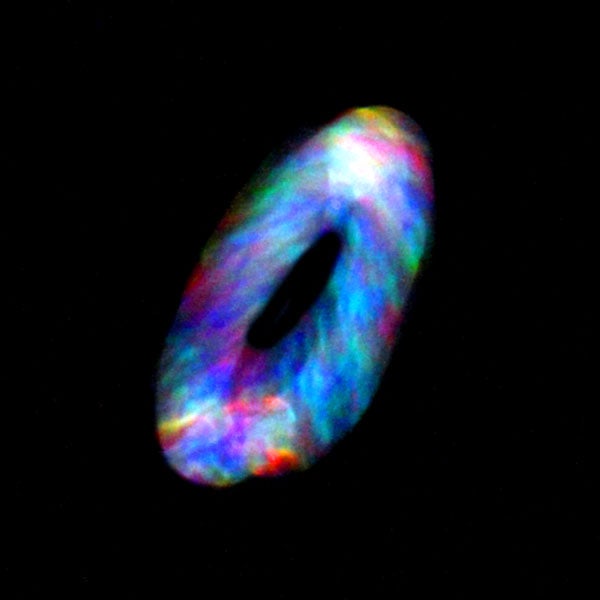Flash dance
Twinkling, the common term for stellar “scintillation,” refers to tiny, rapid changes in a star’s apparent position, brightness, and color, especially when the star is low in the sky on cold winter nights. In the fourth century b.c., Aristotle tried to explain the spectacle in his treatise De Caelo. He imagined vision as sort of an invisible “tentacle” that reached out and grabbed objects. Information about what it found would then travel back to the brain for interpretation. Aristotle proposed that, because the eye’s tentacle had to stretch an extremely long way to the stars, it would become so weak as to quiver, which we perceive as twinkling.
By the 17th century, astronomers had proposed that stars twinkle because they either rotate (flashing like diamonds in the sky as they present different facets to the observer) or have rapid “paroxysms,” like the flaring and dimming of variable stars.
These air bundles act like lenses that continually bend starlight in random directions, causing us to see it tremble and blink — much the way objects quiver and sway when seen through heat rising from a hot surface (a phenomenon known as terrestrial scintillation).
The air cells also can provoke incoming starlight to pulse in and out of focus as light rays rapidly converge and diverge, respectively — like the contracting and expanding loops of sunlight seen reflecting off the surface of rippling water.
Add all these little distortions up and each star becomes its own continually changing “fun house” of light that can entertain us for hours on end.
Project “twinkle”
In the January 1860 edition of The London, Edinburgh and Dublin Philosophical Magazine and Journal of Science, Charles Dufour, a professor of mathematics at Morges, Switzerland, noted that, as far as he was aware, no one had made a series of regular observations of the scintillation of the stars. “I believe I am the first who has undertaken a work of this kind,” he announced. “My observations, commenced at Morges in 1852, were at first but a series of gropings in the dark, but since 1853 down to the present time, I have never allowed one evening to pass in which the stars were visible, without carefully observing the scintillation; and after six years’ perseverance in the work, I am convinced that this branch of astronomical study is important, and merits a place amongst meteorological observations.”
From his studies, Dufour noted the following points:
First, scintillation “varies very considerably” from one night to another and from one location to the next.
Second, it increases or decreases proportionally for all the stars, except for those near the horizon, where the twinkling is always large (because the density of the atmosphere is greatest).
Third, twilight almost always severely augments the twinkling of stars, as do clouds passing near them.
Fourth, on nights of marked scintillation, stars in all directions, including the zenith, are affected; on nights of low scintillation, stars at the zenith shine steadily.
My studies, though not as extensive, agree with most of these points, but I’m not certain about the effects of twilight on twinkling. I’ve noticed this myself, and tend to agree with the late Marcel Minnaert, who, in his 1993 book Light and Color in the Outdoors, suggests that it must be either an illusion or a consequence of odd atmospheric conditions around then.
I would add two points about scintillation: (a) Stars with warm hues, like golden Arcturus (Alpha [α] Boötis) and orange Betelgeuse (Alpha Orionis), lack the cooler shades of color in their spectral flashes; and (b) the faintest twinkling stars can blink in and out of view for a tiny fraction of a second when scintillating, proving that sometimes our eyes receive hardly any starlight.
Look at Sirius (Alpha Canis Majoris) through binoculars or a refracting telescope, defocus the image so that it appears as a small disk, and watch what happens. Although scintillation occurs too fast for us to see in full, we can appreciate it in part. Because the eye retains images for a fraction of a second, everything we see is a subtle blend of the present and what we saw a fraction of a second earlier — a phenomenon dubbed the “persistence of vision.” This means you can see scintillation as a ballet of light variations and color on the disk.
On the best nights, a variety of hues will sweep across the disk in rapid succession. The colors take the shape of swirls, waves, and patches, and can appear from any direction at any time.
Finally, try this: Gently but rapidly tap the telescope tube with your fingers so that the star creates an ellipse of light. The effect is stunning and profound. It creates a lovely loop that not only varies in intensity along its circumference but also features every color imaginable. Both the light variations and the colors constantly shift position, rotating around the loop like flashing lights on an amusement park ride.
Enjoy the show, and let me know what you see at someara@interpac.net.















